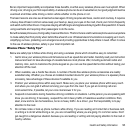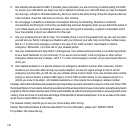130
from RF absorption use special phone cases, while others involve nothing more than a metallic accessory attached to
the phone. Studies have shown that these products generally do not work as advertised. Unlike “hand-free” kits, these
so-called “shields” may interfere with proper operation of the phone. The phone may be forced to boost its power to
compensate, leading to an increase in RF absorption. In February 2002, the Federal trade Commission (FTC) charged
two companies that sold devices that claimed to protect wireless phone users from radiation with making false and
unsubstantiated claims. According to FTC, these defendants lacked a reasonable basis to substantiate their claim.
9. What about wireless phone interference with medical equipment?
Radio frequency energy (RF) from wireless phones can interact with some electronic devices. For this reason, FDA
helped develop a detailed test method to measure electromagnetic interference (EMI) of implanted cardiac pacemakers
and defibrillators from wireless telephones. This test method is now part of a standard sponsored by the Association for
the Advancement of Medical instrumentation (AAMI). The final draft, a joint effort by FDA, medical device manufacturers,
and many other groups, was completed in late 2000. This standard will allow manufacturers to ensure that cardiac
pacemakers and defibrillators are safe from wireless phone EMI.
FDA has tested hearing aids for interference from handheld wireless phones and helped develop a voluntary standard
sponsored by the Institute of Electrical and Electronic Engineers (IEEE). This standard specifies test methods and
performance requirements for hearing aids and wireless phones so that no interference occurs when a person uses a
compatible phone and a compatible hearing aid at the same time. This standard was approved by the IEEE in 2000.
FDA continues to monitor the use of wireless phones for possible interactions with other medical devices. Should harmful
interference be found to occur, FDA will conduct testing to assess the interference and work to resolve the problem.
10. What are the results of the research done already?
The research done thus far has produced conflicting results, and many studies have suffered from flaws in their research
methods. Animal experiments investigating the effects of radio frequency energy (RF) exposures characteristic of
wireless phones have yielded conflicting results that often cannot be repeated in other laboratories. A few animal studies,
however, have suggested that low levels of RF could accelerate the development of cancer in laboratory animals.
However, many of the studies that showed increased tumor development used animals that had been genetically
engineered or treated with cancer causing chemicals so as to be pre-disposed to develop cancer in the absence of RF
exposure. Other studies exposed the animals to RF for up to 22 hours per day. These conditions are not similar to the
conditions under which people use wireless phones, so we don’ t know with certainty what the results of such studies
mean for human health.
Three large epidemiology studies have been published since December 2000. Between them, the studies investigated
any possible association between the use of wireless phones and primary brain cancer, gioma, meningioma, or acoustic


















